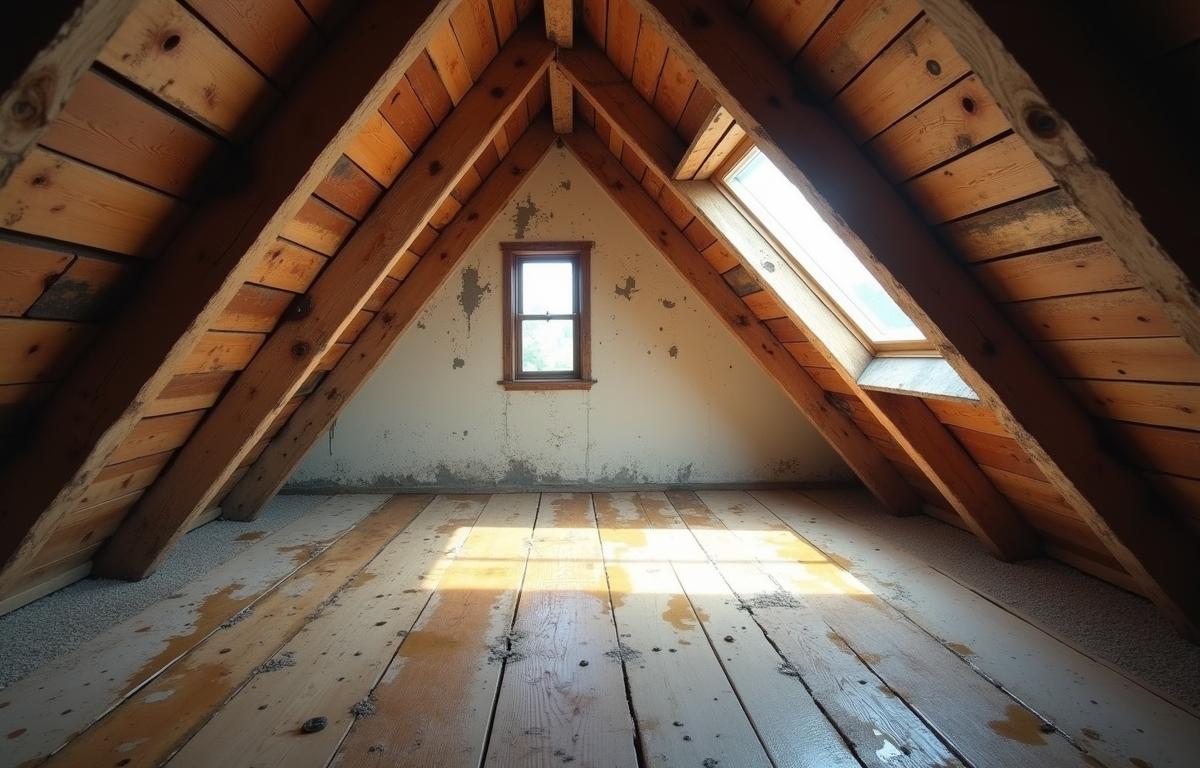A leaking roof can be a homeowner’s worst nightmare. It can quickly turn from a small problem into a costly one. Water damage can harm your walls, ceilings, insulation, and your home’s structure. That’s why it’s important to fix a roof leak as soon as possible.
The attic is the buffer zone between your roof and the rest of your home. That means it’s also the first place where water damage usually appears. If you catch the problem early, you can avoid major repairs and high costs. Here’s everything you need to know:
Signs of Roof Leak in Your Attic
Leaks can hide in plain sight. These warning signs often appear first in your attic. Here are some signs of roof leak in attic:
- Wet insulation: If your attic insulation feels damp or smells musty, that likely means water has made its way in. Wet insulation traps moisture and makes your home less energy-efficient.
- Discolored wood: You might spot dark stains or patches on wooden beams. That’s bad news. These discolorations often indicate slow, steady leaks that have gone unnoticed.
- Mold or mildew: You might see mold or mildew forming on the wood or drywall. Mold feeds on moisture, and its presence in the attic usually means water is getting in.
- Rusty nails or fixtures: Rust doesn’t just happen overnight. It means there has been a problem going on for a while. Rust on nails, brackets, or air ducts may also point to excess moisture in the attic. It only forms when water consistently reaches those metal parts.
- Sunlight through the roof boards: If you see sunlight coming through the roof boards, water can come through as well. Any visible hole, no matter how small, should be addressed immediately.
What Causes Attic Leaks?
Roof leaks usually begin when water goes through your roofing materials and into your home’s structure. A variety of problems can allow that to happen. Some of them include:
- Missing or damaged shingles: Shingles protect your roof deck. If they’re missing, cracked, or curling, they let water slip through.
- Faulty flashing: Flashing surrounds chimneys, skylights, and vents. When it loosens or rusts, water finds a path inside and wreaks havoc everywhere.
- Clogged gutters: Clogged gutters can cause water to pool on the roof instead of draining properly, which forces water underneath the roofing layers.
- Poor attic ventilation: This can create condensation inside the attic. If left unchecked for too long, condensation can mimic the effects of a roof leak.
- Aging roofing materials: Over time, roofing materials break down. Even if nothing is visibly broken, the roof may no longer keep moisture out effectively.
Why Quick Action Matters
Many homeowners ignore early signs, hoping the problem will go away. Unfortunately, this approach never works. It only makes things worse. The longer you wait, the worse the damage becomes. Here’s why it’s important to act fast:
- Water spreads: Water rarely stays put. Moisture travels beyond the attic.It can reach walls, ceilings, wiring, and insulation.
- Costs rise: A small leak can be repaired for a few hundred dollars. Larger jobs involving structural repairs, mold remediation, or full roof replacement can cost anywhere between $6000 to $30,000.
- Safety risks grow: Wet wood can rot and smell nasty. Mold can affect indoor air quality and lead to serious health issues. Damaged wiring can lead to fire hazards. These are problems you definitely don’t want to deal with.
How to Handle a Leak
If you notice any signs of a leak problem, here’s what you should do:
- Inspect the roof: Take a good look at the problem sites to figure out what’s going on. From the outside, look for missing shingles, loose flashing, or debris buildup.
- Call a professional: Hire a licensed roofing contractor for the job. Ask them to inspect both the exterior and attic thoroughly.
- Get a written estimate: Make sure the contractor explains the source of the leak and provides a breakdown of repair costs.
Endnote
Your attic holds the clues to your roof’s health. If you inspect it regularly, you’ll catch problems early and avoid bigger issues later. By recognizing the signs and acting quickly, you can protect your home, your budget, and your peace of mind.
